The Amateur Mycologist #34 - A Parasitic Fungal Organism Devoured This Bug's Body And Burst Out Of It's Mouth - What Is it? - We Take An Extremely Close Look And Develop An Informed Hypothesis
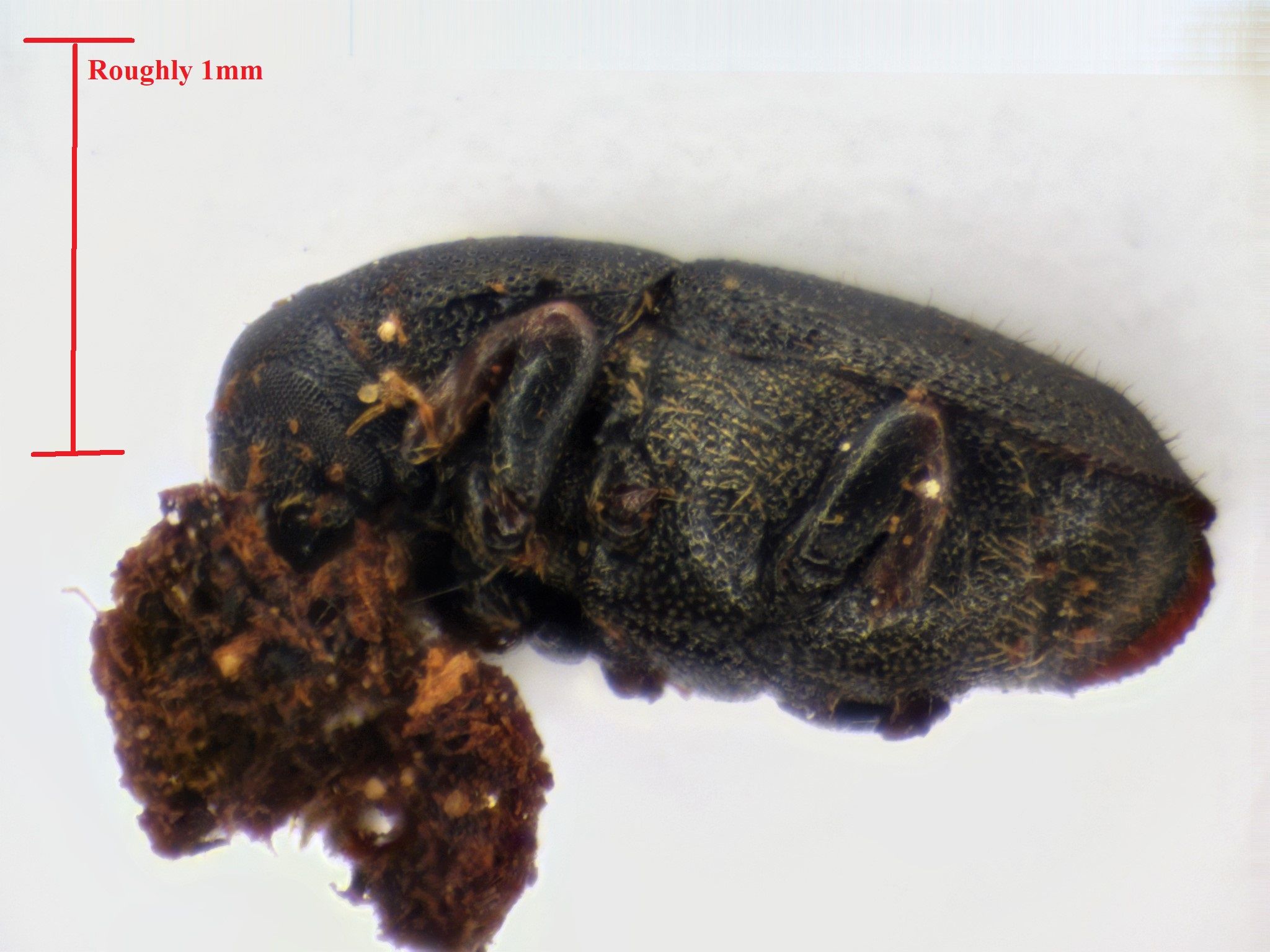
Welcome to the weird weird world of minute fungal parasites.
We have discussed once before a species of parasitic fungus, Cordyceps capitata. That mushroom was pretty awesome in that it grew out of another mushroom buried underground. Some may remember how unhappy I was not to have dug up the host as well.
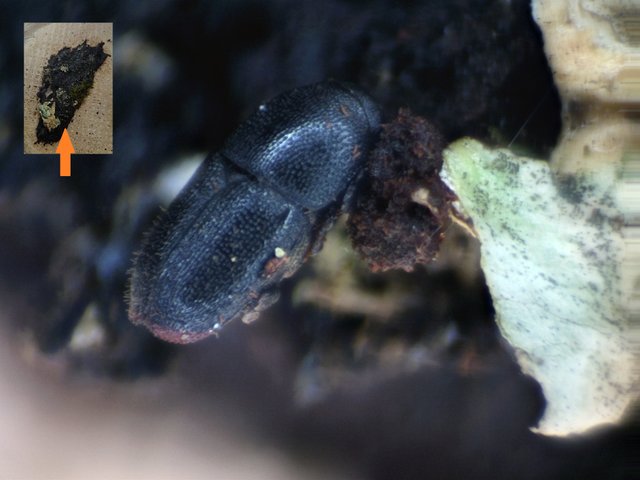
Today is helping make up for that mistake. What we have here is a tiny little bug - 2.9mm by 1mm in size as measured by my handy dandy digital calipers. Earlier this week I posted a teaser photo of this little guy, apparently resting on the surface of the bark. But this picture was deceptive. In reality, the bug was not really resting on the bark, it was glued to the larger fungus by a grotesque brown mass apparently protruding from its face.
When I say glued, I mean glued. It took some significant prodding with a dissecting needle to free this little guy from his final resting place. And, when I finally did, the tenacious brown mass came loose with him.
It took even more prodding with two needles to get the brown mass separated from the poor bastard's face. When I finally did, I thought the old buggy deserved a close up.
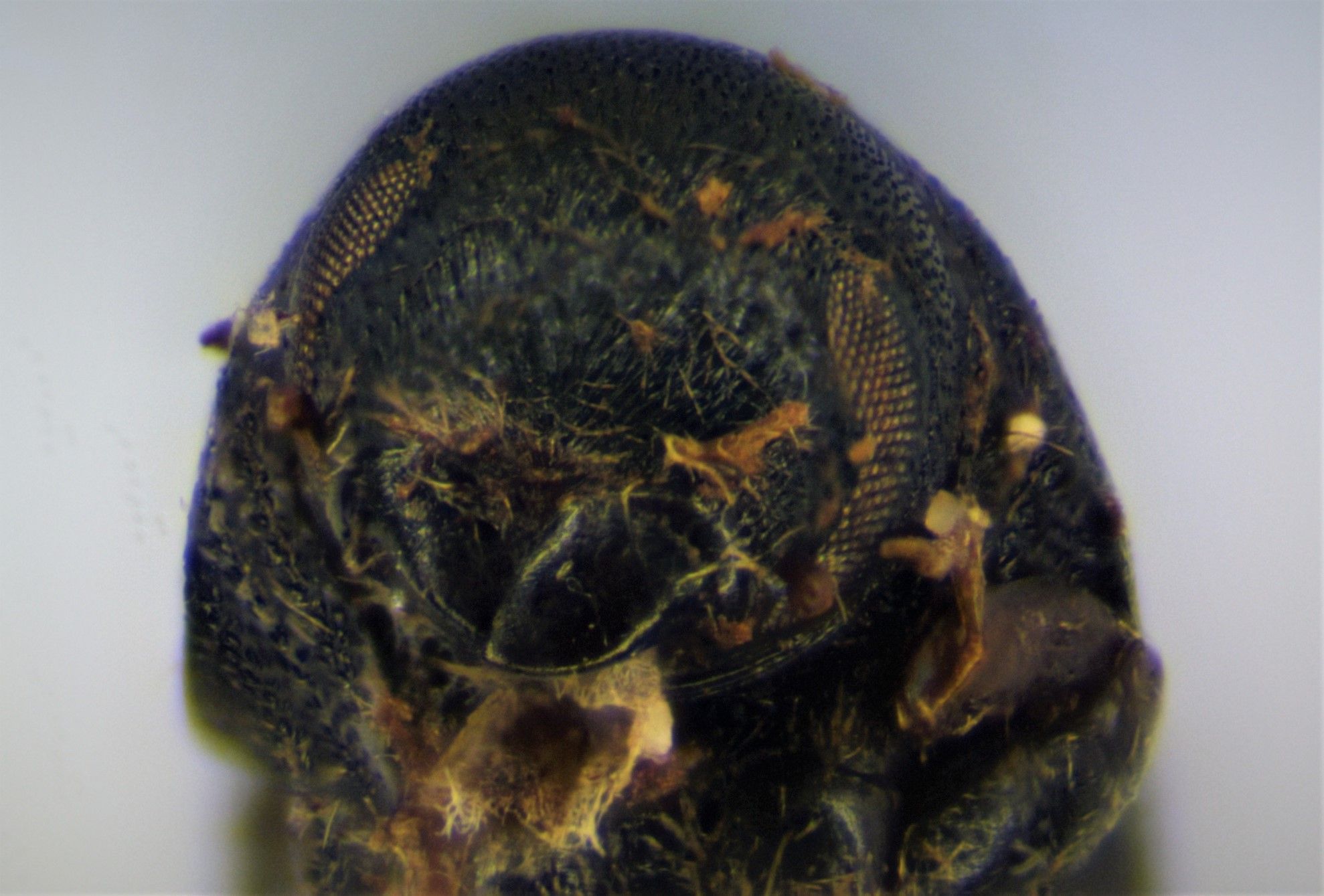
Can you make out the buggies tiny little face?
The detail on his absolutely infinitesimal faceted eyeballs? The two pincer like mouth pieces? I'm sorry that this photo is not perfectly in focus. It, and all the others here, is one of the first photos I took with the new scope and camera combo. These photos took a long time to get - mostly positioning the critter, light and objectives. But then I needed to take a series of VERY shallow depth of field photos. If you look at the creature's forehead, you can see I sort of missed a spot.
But I'm not disappointed. The bug has a number of spots and growth-like things scattered around his face, and particularly visible here on the tip of his left leg. Like the last post, I posted some of this information on the NYMS forum and reddit to try and get some input. One user, seeing only that first photo at the top, postulated that this might just be a dead bug and some dirt.
Let's dispel that notion.
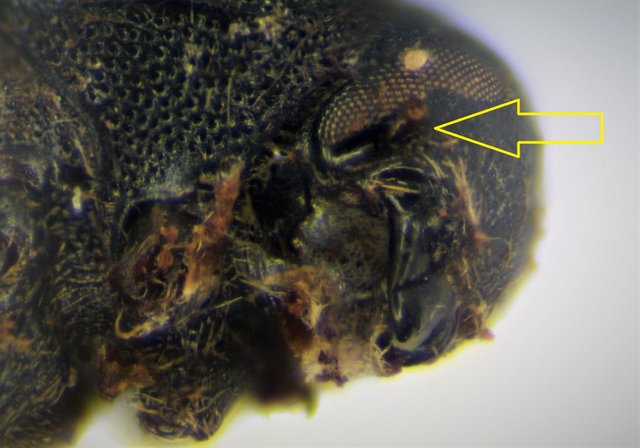
See that thing growing out of it's right eye socket?
Not to mention the latticed strangeness going on under his pincers. And the fact that if that brown mass was just dirt, it was some aggressively sticky dirt.
Here's an even better view of the eye growth.
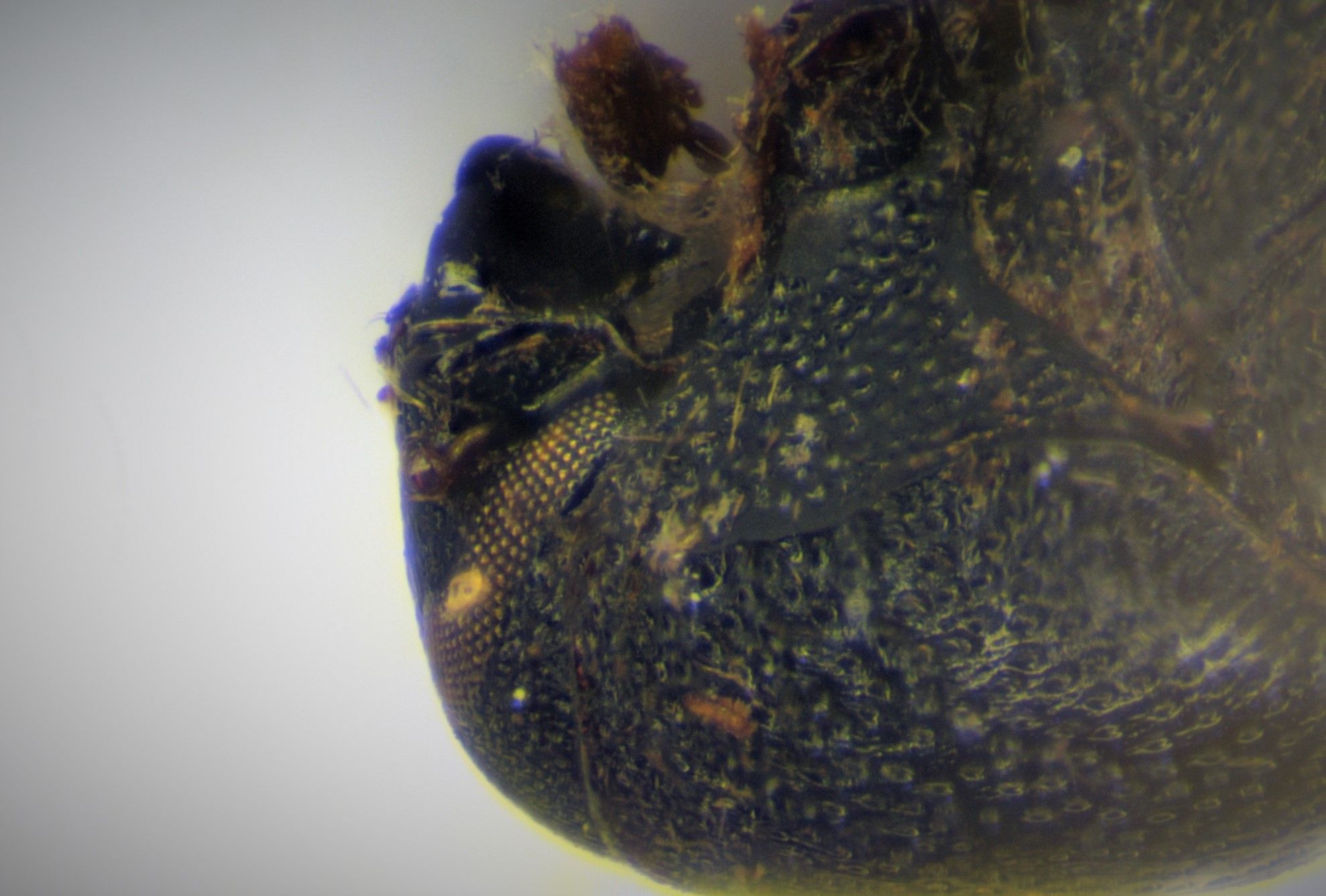
You can see the structure of that eye growth even more clearly.
You can also see the remnants of the dark brown stuff coming out of the mouth.
Leaving aside the fungal elements of these photos, how awesome is the rhinoceros-like carapace of this beetle!? That dimpled texture and overlaying plate structure! The tiny hairs you can see in some of the photos above! The amount of detail I was able to capture using a 3MP camera and a low end scope was just astounding to me.
Here's a weird one

I wanted to dissect this guy and attempted to cut him in half - but instead it exploded into pieces.
I should have seen this coming. It was so old and mummified that even a slight amount of pressure from the razor blade smashed the thing into pieces that flew across my little desk and made me leap up in disgust. After building up the courage to return and examine the remains, I was able to take this shot above of the disembodied eyeball - not sure if it's left or right - showing a clear growth coming from the eyeball, as well as a close look at the facets of the eye. You can also see some thicker orange stuff which may also be fungal in nature.
In examining the remains, I also took a picture of the inside of half of the bugs carapace, and though the details were blurrier than I'd have liked, I felt pretty sure I could see hyphae in there, the webby strands that make up mycelium. Unfortunately, I can't find where I saved that photo, and I dropped the petri dish containing this disgusting mess and felt compelled to vacuum, so the photo may be lost with time.
At this point, any possibility that this may just be dirt seems unlikely, but I think the next picture confirms it.
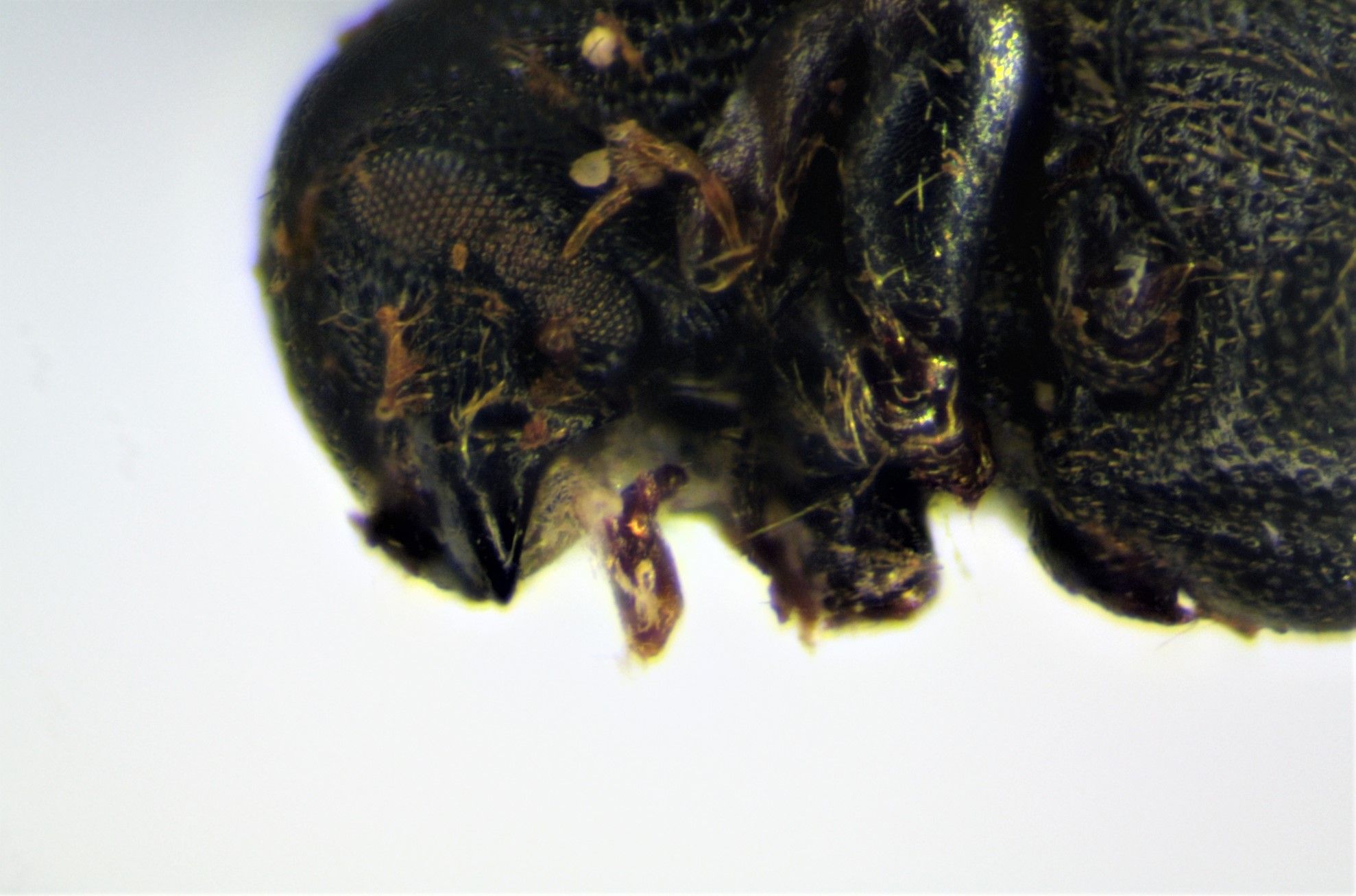
Here, we can see very clearly the white web filling the cavity that was the bug's mouth area.
As well as the small darker brown bit remaining, attached to the white webbing. It seems as straight forward as possible to conclude that some kind of organism was growing inside of this buggy and, either took over and killed the buggy, or waited for the buggy to die and then took over.
Let's take a look at some of the that brown stuff under a scope.

This dramatic, if empirically unhelpful, photo is the best I could come up with.
The brown mass coming from the bugs mouth was not very translucent, and my microscope's light source and objective just ain't that great. I did not see anything that looked like a spore, as I could tell. But by placing the 40x objective in the center of the dry mounted specimen, upping the exposure, taking a series of photomicrographs and then stacking them together digitally, I was able to produce a photo that should be the final nail in the coffin of the dirt theory.
Which leaves us...where...confused? A little bit - but maybe less so than last time.
My original assumption was that this must be some kind of Cordyceps species, as that was the only species I was familiar with that parasitizes host insects. However, the sorts of Cordyceps I was familiar with grew on a much larger scale than this tiny thing. These generally produced large enough fruiting bodies to be grabbed and picked by human hands. Here we had something entirely smaller
I have two working hypothesis, and unfortunately neither is easily capable of being confirmed or disproved. The inability to find the spores hurts my chances big time, but in general the tiny size of this investigation greatly confuses matters. Nonetheless, here are my thoughts based on the reading I've done:
Cordyceps is not off the table entirely. Like all fungi, Cordyceps species spread by microscopic spores. There's no fundamental reason that the spores would not take hold on a compatible bug that was smaller than average. Once that was done, the bug itself, being the growth medium, might limit the extent of the Cordyceps growth, resulting in a weird final fruiting body we see here.
This could be a form of a **very specific group of fungi, the Laboulbeniomycetes. These fungi are parasitic, like Cordyceps species, however they do not tend to kill the host. Instead, they live off of the hosts body, being carried around and spread from bug to bug. Laboulbeniomycetes tend to be absolutely tiny, with fruiting bodies that are well under 1mm. They also seem to present in a variety of tendril/spiked forms, usually off of legs or carapaces of bugs. And according to Peterson, species of Laboulbeniomycete are often specifically correlated to specific species of beetle.
If you go back through the photos above, you can see a variety of strange, non-hair marks all over the creatures body, separate and apart from the obvious growth from his eye and out of his mouth. What I think may have happened here is that this guy was infected, in life, by a Laboulbeniomycete species of some kind. That fungus was kept at bay while the bug was alive, but perhaps once it died the fungus basically took over the nutritional medium - a.k.a the bug's undefended corpse. Which is to say, the bugs awful condition could, perhaps, have developed mostly post-mortum.
In truth, of course, I simply don't know. If there was a place to send this to for further analysis or DNA testing, then perhaps we would have a concrete answer. As it stands, I can only say with relative certainty, that whatever came out of this bugs mouth and stuck it in place like glue was not dirt. The various tiny growths, looking a lot like fruiting bodies, as well as the hyphae remnants inside the carapace, lead me to believe it was a fungal organism of some kind - potentially a Cordyceps or Laboulbeniomycetes species run amok post death.

Whatever it is - it's totally macabre and awesome looking. Each photo here took quite a lot of time - but it was well worth it. I hope to take more photos of the tiniest buggies, if I'm able to find them.
But next week, we remain on small fungi...or slime molds? I really don't know yet - but I caught whatever they were on time lapse.
Photos Are My Own
Microscopic photos were taken using an AmScope SM-4TZ-144A dissecting microscope and an AMScope M150B entry level microscope. The camera lens is also AMScope, MU300.
Information Sources
Efforts were made to identify the species using the following books:
[1] Myxomycetes A Hand Book of Slime Molds By Steven L Stephenson and Henry Stempen
[2]The Audubon Society Field Guide To North American Mushrooms by Gary Lincoff
[3]Mushrooms Demystified By David Arora
[4]"The Kingdom of Fungi", by Jens H Peterson, p.100-101
[5]Wikipedia on Laboulbeniomycetes
[6]New Brunswick Museum on Laboulbeniomycetes
Poor little guy
Not the best way to end up. :(
Next time I smash the bug, I will feel less guilt. Maybe I saved it from That :)
Haha!
This.. haha.
Nature is cruel and I love it.
Ditto - as long as the parasite isn't eating me ;)
Wow the detail you have captured is amazing, you caught me right off with the title but the photos wow, I'm very impressed with the new microscopic camera. What a way to go, if that fungi was the cause of death, so fascinating that growth out the eye. Great post.
I have been getting down on the resolution of some of the photos I've taken since, but these were all annew level of complexity for me. Plus I'm learning a ton about how to do extreme macro and micro photography and I think I'm figuring out a camera buying plan...
When I saw the title I immediatly though Cordyceps as well! Interesting whatever it is!
Wow... the picture reminds me why I didn't become a biologist. I solute you doing all these works by yourself!
Lol, me too a little.
I think some fungi don't need the standard warning in the beginning of the post, I can't imagine who'd eat this stuff! With a generous helping of bug what's more!
Ahem, when you say exploded? This is getting more terrifying as I read.
Overall, this is a well-written, beautifully shot, horror detective story! Reminds me of The Wailing.
Haha - I agree re: the disclaimer - I got rid of the one at the bottom :).
The bug-splosion occurred after a few hours over the microscope, so I was not thinking totally straight and it woke me right up. I actually have a bit of a bug related fear so I sort of freaked.
Awesome bug consuming fungi - love it. Nasty way to go though.
Yeah, definitely a distasteful end - makes you glad theres no Cordyceps that affects homo sapiens
Well I'll never turn down a free token I suppose - my bitshares address is dber1
This "thing" is so weird, but your detailed post changed my mind, is fantastic !!